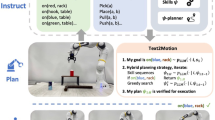Abstract
Motion planning for a point robot is studied in a time-varying environment. Each obstacle is a convex polygon that moves in a fixed direction at a constant speed. The point to be reached (referred to as the destination point) also moves along a known trajectory. The concept of “accessibility” from a point to a moving object is introduced, and is used to define a graph on a set of moving obstacles. If the point robot is able to move faster than any of the obstacles, then the graph exhibits an important property: a time-minimal motion is given as a sequence of edges in the graph. An algorithm is described for generating a time-minimal motion and its execution time is analyzed.
Similar content being viewed by others
References
A. V. Aho, J. E. Hopcroft, and J. D. Ullman,The Design and Analysis of Computer Algorithms, Addison-Wesley, Reading, MA, 1974.
T. Asano, T. Asano, L. Guibas, J. Hershberger, and H. Imai, Visibility of Disjoint Polygons,Algorithmica,1(1) (1986), 49–63.
J. Canny and J. Reif, New Lower Bound Techniques for Robot Motion Planning Problems,Proceedings of the 28th Annual IEEE Symposium on Foundations of Computer Science, Los Angeles, CA, October 1987, pp. 49–60.
M. Erdmann and T. Lozano-Perez, On Multiple Moving Objects,Algorithmica,2(4) (1987), 477–522.
K. Fujimura and H. Samet, Accessibility: A New Approach to Path Planning Among Moving Obstacles,Proceedings of IEEE Conference on Computer Vision and Pattern Recognition, Ann Arbor, ML June 1988, pp. 803–807.
S. K. Ghosh and D. M. Mount, An Output Sensitive Algorithm for Computing Visibility Graphs,Proceedings of the 28th Annual IEEE Symposium on Foundations of Computer Science, Los Angeles, CA, October 1987, pp. 11–19. (To appear inSIAM Journal on Computing.)
K. Kant and S. W. Zucker, Toward Efficient Planning: The Path-Velocity Decomposition,International Journal of Robotics Research,5(3) (Fall 1986), 72–89.
S. Kapoor and S. N. Maheshwari, Efficient Algorithms for Euclidean Shortest Path and Visibility Problems with Polygonal Obstacles,Proceedings of the Fourth Annual ACM Symposium on Computational Geometry, Urbana-Champaign, IL, June 1988, pp. 172–182.
T. Lozano-Perez and M. A. Wesley, An Algorithm for Planning Collision Free Paths Among Polyhedral Obstacles,Communications of the ACM,22(10) (October 1979), 560–570.
B. J. Oommen, S. S. Iyengar, N. S. V. Rao, and R. L. Kashyap, Robot Navigation in Unknown Terrains Using Learned Visibility Graphs. Part I: The Disjoint Convex Obstacle Case,IEEE Journal of Robotics and Automation,3(6) (December 1987), 672–680.
F. P. Preparata and M. I. Shamos,Computational Geometry: An Introduction, Springer-Verlag, New York, 1985.
J. Reif and M. Sharir, Motion Planning in the Presence of Moving Obstacles,Proceedings of the 26th Annual IEEE Symposium on Foundations of Computer Science, Portland, OR, October 1985, pp. 144–154.
E. Welzl, Constructing the Visibility Graph forn Line Segments inO(n 2) Time,Information Processing Letters,20(4) (May 1985), 167–171.
S. H. Whitesides, Computational Geometry and Motion Planning, inComputational Geometry (G. T. Toussaint, ed.), North-Holland, Amsterdam, 1985, pp. 377–427.
C. K. Yap, Algorithmic Motion Planning, inAdvances in Robotics, Vol. 1 (J. T. Schwartz and C. K. Yap, ed.), Lawrence Erlbaum, Hillsdale NJ, 1986, Chapter 3.
Author information
Authors and Affiliations
Additional information
Communicated by David P. Dobkin.
The support of the National Science Foundation under Grants IRI-88-02457 and IRI-90-17393 is gratefully acknowledged. This work is supported in part by the Office of Engineering Research Program, Basic Energy Sciences, of the U.S. Department of Energy, under Contract No. DE-AC05-84OR21400 with Martin Marietta Energy Systems, Inc. and in part by an appointment to the U.S. Department of Energy Postgraduate Research Program administered by Oak Ridge Associated Universities.
Rights and permissions
About this article
Cite this article
Fujimura, K., Samet, H. Planning a time-minimal motion among moving obstacles. Algorithmica 10, 41–63 (1993). https://doi.org/10.1007/BF01908631
Received:
Revised:
Issue Date:
DOI: https://doi.org/10.1007/BF01908631




